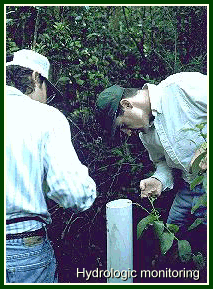
 Department of Conservation and Recreation
Department of Conservation and Recreation
Conserve. Protect. Enjoy.
 Department of Conservation and Recreation
Department of Conservation and Recreation
Natural areas encompass a wide range of environments and support a rich diversity of flora and fauna. From its tidal marshes of the coast to its boreal forests of the mountains, Virginia has been described as an ecological crossroads of national significance. Virginia's Department of Conservation and Recreation (DCR) acquires, dedicates and manages natural areas of statewide significance. The Natural Area Preserve System focuses on preserving lands so that rare natural communities and species may flourish. In addition, DCR advises other levels of government and private owners about managing natural areas. Following acquisition, DCR faces the even greater challenge of natural area stewardship. Stewardship is the long-term management of land to maintain its natural resources and inherent natural beauty. DCR stewardship is a combination of property and ecological management. On any natural area preserve, one may find staff and volunteers searching for rare plants, posting boundary signs, repairing trails or studying hydrology.
Ecological management is focused on maintaining and enhancing the natural values of land to conserve biological diversity. Land protection alone, however, does little to preserve the character of a natural area if impacts such as the introduction of invasive alien plants, or hydrologic disturbances are not also addressed. With continuing alteration of the land by human activity, many ecosystems have become fragmented or reduced to isolated islands surrounded by agricultural fields or developed areas. Ecological management is the key to successful stewardship and can be sub-divided into five general categories: conservation planning, restoration, prescribed management, research and monitoring.
Conservation planning
is the analysis of the ecological, economic and social features of land which provides the scientific foundation for conservation of natural areas. Conservation planning starts well before a natural area is acquired. Planning boundaries are set which delineate ecologically sensitive areas where land-use activities should be carefully managed to ensure that they are compatible with conservation goals for natural heritage resources. Well designed natural area preserves encompass those ecological features necessary for the survival of native flora and fauna, and are planned to permit the best possible management by DCR stewards.
Restoration activities
are implemented in an attempt to return disturbed land or vegetation to its original condition. Fundamental environmental processes critical to ecosystem functioning include water and nutrient cycling, erosion, herbivory, and natural disturbances such as floods and fire. Restoration techniques reinstate or replicate environmental processes to aid the return of an ecosystem to its original state.
Habitat restoration
involves the return of specific habitat features to the environment, and the introduction of specific plants and animals to ensure habitation of the area by native species. Habitat restoration may also involve the removal of invasive or non-native species from the natural area.
Hydrologic restoration
allows for the natural flow of water through a wetland or along a waterway. Maintaining or restoring the movement and chemistry of water encourages certain plants and animals to inhabit an area. Hydrologic restoration may involve the removal of obstructions to water flow, plugging of ditches, or remedial work to improve water quality.
Prescribed management
maintains or enhances environmental conditions of an area. Through management activities such as prescribed burning and invasive species control, natural area stewards protect and rejuvenate natural vegetation. This enhances habitat conditions for many rare species and preserves the integrity of rare communities.
Prescribed burning
is the carefully planned and controlled use of fire to accomplish a management goal. Many natural areas in Virginia such as longleaf pine - turkey oak sandhills and grassy savannahs contain plants that are dependent on or benefit from regular fires to enhance seed germination and make space and nutrients available for new growth.
Invasive species
represent a serious threat to natural areas. Often these species have no natural enemies or controls to curb their growth and dispersal. They can easily outcompete native species for needed resources such as space, sunlight, and food. Once established in disturbed areas, they advance steadily into natural areas and can be difficult to remove. A variety of control methods, such as mechanical removal and the use of environmentally safe herbicides, are used by natural area stewards to control invasive species.
Research
is important to the long-term preservation of a natural area for identifying the environmental conditions necessary to support a particular community or species of interest. Information to guide management of rare species or communities is often lacking. Research aimed at understanding the natural history, biology, and population dynamics of a rare species or how an ecosystem functions is essential for planning effective management.
Monitoring
is a multi-faceted tool used by natural area stewards to assess the ecological condition of an area. It is used to document the trends of natural communities and rare species. It can also help determine if the natural processes essential to their continued existence are occurring. Monitoring is not limited to assessing only the condition of plant and animal species. Air, water, land, and pollution are other components of the environment that must be monitored for effective resource management. Monitoring activities also inform natural area stewards if management activities have been successful in fulfilling their goals. Information obtained through monitoring can be used to further refine and enhance current management practices.

Effective stewardship of Virginia's natural areas is dependent on the dedication of a variety of people. Land managers, resource experts, conservation planners, and private landowners all contribute to sound ecological management practices. Volunteers also contribute significantly to preserving natural areas through assistance with monitoring, prescribed management and restoration projects. If you are interested in learning more about Virginia's natural area preserves and ecological management programs, contact the Department of Conservation and Recreation at (804) 786-7951.

